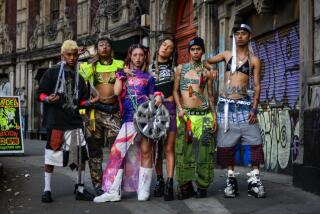Primp My Ride
- Share via
In the hyper-competitive world of newsstand sales, a magazine’s cover design usually determines how well an issue will sell. Consider Lowrider, the magazine that’s been promoting the lowered-car lifestyle since 1977. Every month it finds itself shelved in the “Transportation” or “Automotive” sections at newsstands, its 200-plus glossy pages duking it out with Custom Rodder, Ol’ Skool Rodz and Muscle Car Review. How do Lowrider editors and designers attract customers and persuade them to part with the five-buck cover price? Let’s deconstruct the August issue.
Lowrider settled on its arching, gold-plated nameplate in 1978. “A lot of [the lowrider car clubs] started out having that arched shape to their plaque,” says Gene Coo, one of the magazine’s art directors, referring to the accessory commonly displayed in the rear windows of club members’ cars. “Publishers in the past wanted as little of the logo covered [by a model] as possible,” Coo says. Current management isn’t opposed to a pretty face obscuring a letter here and there. One thing remains constant, though. When Coo and another art director, Robert Munoz, changed the lettering to silver for the magazine’s 25th anniversary issue, the staff rebelled. The Lowrider name has to represent in gold.
Sex sells, so the staples of a Lowrider cover are a well-proportioned, barely dressed young lady standing next to, or straddling some part of, a custom car. Frame these two objects of desire with a catchy cover line that may or may not be a double-entendre, fill in the background with some complementary fruity colors, and you’ve created the periodical equivalent of a Popsicle. It wasn’t always such a colorful world for Lowrider, which began in the San Jose bedrooms of two college students, Sonny Madrid and Larry Gonzales. “If Chicano culture is a subculture of a community, then lowriding was a subculture of the Chicano community,” Gonzales says. The original issue featured cars and modestly dressed girls, but also included a political rant against the sitcom “Chico and the Man” for misrepresenting Chicano life. The political message has mostly evaporated--Lowrider is now owned by Primedia, the billion-dollar media conglomerate--and so too has much of the models’ clothing. Lowrider also publishes a babeless version of the cover to appease “family friendly” businesses such as Auto Zone and Blockbuster.
Landing a cover of Lowrider is like winning a Grammy or Oscar for many customizers and car owners. It’s a stamp of legitimacy from the Lowrider staff. When Johnny Borrego spotted this abandoned ’81 Cadillac Coupe de Ville at a San Antonio body shop, he knew it had the potential to become a great lowrider. He forked over $1,200 and took it to Fabian Villarreal, the owner of Kandy Kustoms in Corpus Christi. Borrego literally wanted to pimp his ride, to get it somewhere in the pages of Lowrider, as well as win car shows and prize money. Villarreal got to work. He took the car apart, lug nut by lug nut. He candy-flaked the frame and brought in muralist John Faenz to airbrush fleshy likenesses of Pamela Anderson, Kristy Swanson and Carmen Electra. Eight months and $34,000 later, Borrego had his dream car. Getting the cover? That was beyond Borrego’s wildest dreams.
The double-entendre “cover your assets” adds some juvenile intrigue to a grown-up message inside the mag. In this case, the words draw readers’ attention to appraisal and insurance suggestions. As you can see, very few cover lines interfere with the two primary objects of desire.
Models bring their own clothes to their cover shoots, but the staff outfitted Miss August with a Lowrider tank top. Well-placed merchandise helps define a magazine’s brand--and the attitude that comes with it.
For the August issue, model Sheena Lee, a 22-year-old Dallas native, nabbed the cover. Lee represents the new breed of Lowrider babe. In the past, the women have been mostly Latina--dark hair, dark complexion--but the models have become more diverse as lowrider culture has broken into the mainstream. In the future, models such as Lee, a mix of Filipino, Chinese and German, will grace the cover more often. “We get a lot of letters that say leave the girls out,” Coo says. Sometimes irate readers even accuse the mag of misrepresenting lowrider culture when a model’s physical features don’t match the traditional look. But don’t expect the staff to take these suggestions too seriously. They know that babes sell fantasy--and newsstand copies. Even Lee agrees: “If you drive this car, you’ll get hot chicks. That’s the idea they’re trying to put in your head.”
“He’s like an old zoot-suit Mexican,” says Munoz of Lowrider Man, the magazine’s official symbol of coolness. Throughout the pages of Lowrider, Lowrider Man punctuates ends of sentences, is ironed onto merchandise and sometimes slips onto the cover in a “Where’s Waldo?” sort of way. Originally designed by co-founders Madrid and Gonzales, and modeled after Madrid, Lowrider Man pops up on about half of the covers, either dropped into lettering, as in this issue, or transposed subliminally where only the most perceptive reader might pick him out. Lowrider Man is the anti-Eustace Tilley, whose top hat and monocle helped define the wit, irony and sophistication of the New Yorker. From behind a pair of dark shades, this confrontational Chicano from the days of disco wears a frowning pencil-thin mustache and looks you right in the eye from beneath a Mafioso fedora.
Throughout the year Lowrider publishes theme issues highlighting a region or country’s lowrider culture. Past issues have documented the German and Japanese scenes, but in the August issue, Texas lowriders get their star turn. Red, white and blue aren’t just the colors of the Texas flag; they’re emblematic of what many consider the All-American state. Coo chose the “Black Oak” font to emphasize the size and feel of the West.






